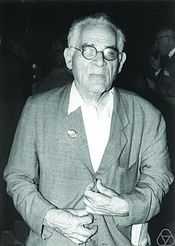Louis J. Mordell
| Louis Mordell | |
|---|---|
 Louis Mordell in Nizza, 1970. | |
| Born |
Louis Joel Mordell 28 January 1888 Philadelphia, Pennsylvania |
| Died | 12 March 1972 (aged 84) |
| Nationality | British |
| Fields | Mathematics |
| Institutions |
Birkbeck College University of Manchester University of Cambridge |
| Alma mater | St John's College, Cambridge[1] |
| Doctoral advisor | Henry Frederick Baker[2][3] |
| Doctoral students |
Ram Prakash Bambah Eric Barnes J. W. S. Cassels John Chalk Clive Davis[2][3] |
| Known for |
Chowla–Mordell theorem Mordell–Weil theorem Erdős–Mordell inequality |
| Notable awards | Fellow of the Royal Society[1] |
Louis Joel Mordell (28 January 1888 – 12 March 1972) was an American-born British mathematician, known for pioneering research in number theory. He was born in Philadelphia, USA, in a Jewish family of Lithuanian extraction.
Education
Mordell was educated at the University of Cambridge where he completed the Cambridge Mathematical Tripos as a student of St John's College, Cambridge starting in 1906 after successfully passing the scholarship examination.[1]
Research
After graduating Mordell began independent research into particular diophantine equations: the question of integer points on the cubic curve, and special case of what is now called a Thue equation, the Mordell equation
- y2 = x3 + k.
He took an appointment at Birkbeck College, London in 1913. During World War I he was involved in war work, but also produced one of his major results, proving in 1917 the multiplicative property of Ramanujan's tau-function. The proof was by means, in effect, of the Hecke operators, which had not yet been named after Erich Hecke; it was, in retrospect, one of the major advances in modular form theory, beyond its status as an odd corner of the theory of special functions.
In 1920 he took a teaching position in UMIST, becoming the Fielden Chair of Pure Mathematics in at the University of Manchester in 1922 and Professor in 1923. There he developed a third area of interest within number theory, geometry of numbers. His basic work on Mordell's theorem is from 1921/2, as is the formulation of the Mordell conjecture.
He took British citizenship in 1929. In Manchester he also built up the department, offering posts to a number of outstanding mathematicians who had been forced from posts on the continent of Europe. He brought in Reinhold Baer, G. Billing, Paul Erdős, Chao Ko, Kurt Mahler, and Beniamino Segre. He also recruited J. A. Todd, P. Du Val, Harold Davenport, L. C. Young, and invited distinguished visitors.
In 1945 he returned to Cambridge as a Fellow of St. John's, when elected to the Sadleirian Chair, and became Head of Department. He officially retired in 1953. It was at this time that he had his only formal research students, of whom J. W. S. Cassels was one. His idea of supervising research was said to involve the suggestion that a proof of the transcendence of the Euler–Mascheroni constant was probably worth a doctorate. His book Diophantine Equations (1969) is based on lectures, and gives an idea of his discursive style.
References
- ↑ 1.0 1.1 1.2 Cassels, J. W. S. (1973). "Louis Joel Mordell 1888-1972". Biographical Memoirs of Fellows of the Royal Society 19: 493. doi:10.1098/rsbm.1973.0018.
- ↑ 2.0 2.1 O'Connor, John J.; Robertson, Edmund F., "Louis J. Mordell", MacTutor History of Mathematics archive, University of St Andrews.
- ↑ 3.0 3.1 Louis J. Mordell at the Mathematics Genealogy Project
| Educational offices | ||
|---|---|---|
| Preceded by (none) |
Fielden Chair of Pure Mathematics 1922–1945 |
Succeeded by Max Newman |
|